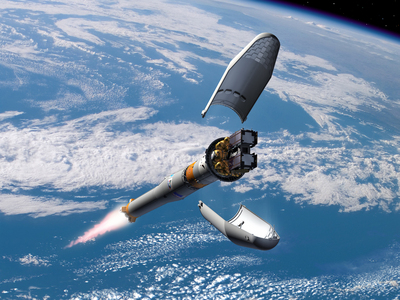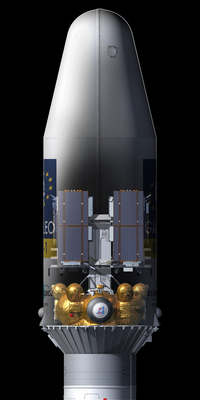International space cooperation will be highlighted in a historic event on 20 October: the launch of Europe’s first Galileo navigation satellites on Russia’s first Soyuz rocket to depart from Europe’s Spaceport in French Guiana.
 Credits: ESA - D. Ducros
Credits: ESA - D. Ducros
Liftoff is scheduled for Thursday, 20 October at 12:34 CEST (11:34 GMT, 07:34 local time).
The launch will be the first time that Russia’s venerable Soyuz vehicle has ascended from European territory, adding a trusted workhorse to Europe’s launchers family.
This Soyuz-2 version is the latest in the renowned family of Russian rockets that began the space race more than 50 years ago by carrying both the first satellite, Sputnik, and the first man, Yuri Gagarin, into space.
Riding Soyuz will be the first two operational satellites in the Galileo constellation that will provide Europe with an independent global satellite navigation system.
The twin Galileo satellites were glimpsed for the very last time by human eyes yesterday as they were enclosed within their upper stage Soyuz launch fairing in preparation for their 20 October launch.
The previous week saw the pair of Galileo In-Orbit Validation satellites attached to their supporting dispenser. On Monday, the combined satellites plus dispenser were mated to the Fregat-MT upper stage that will transport them into their final 23 222 km orbit.
The mating complete, the halves of the Soyuz fairing were closed around the stack on Wednesday to form the ‘Upper Composite’.
The Galileo launch team watched intently as Russian technicians completed the encapsulation.
The satellites are now out of sight but hardly out of mind: they are monitored continuously via the data and power umbilicals that connect them to the outside world.
Two days before launch they will be subjected to a full launch dress rehearsal along with their Fregat.
On Friday the Upper Composite is due to be moved from the Upper Composite Integration Stand of building S3B to the Soyuz launch site, where it will be mated vertically to its three-stage Soyuz ST-B rocket, using the mobile tower.
Galileo
These first two Galileo satellites will be followed next year by two more. This quartet, built by a consortium led by EADS Astrium Germany, will form the operational nucleus of the full Galileo satnav constellation.
They combine the best atomic clock ever flown for navigation – accurate to one second in three million years – with a powerful transmitter to broadcast precise navigation signals.
The two Galileo In-Orbit Validation satellites are protected during their launch by Soyuz by a launch fairing. Once the Soyuz has passed most of the way through the atmosphere, this fairing can then be ejected.
 Credits: ESA -. P. Carril, 2011
Credits: ESA -. P. Carril, 2011

Liftoff is scheduled for Thursday, 20 October at 12:34 CEST (11:34 GMT, 07:34 local time).
The launch will be the first time that Russia’s venerable Soyuz vehicle has ascended from European territory, adding a trusted workhorse to Europe’s launchers family.
This Soyuz-2 version is the latest in the renowned family of Russian rockets that began the space race more than 50 years ago by carrying both the first satellite, Sputnik, and the first man, Yuri Gagarin, into space.
Riding Soyuz will be the first two operational satellites in the Galileo constellation that will provide Europe with an independent global satellite navigation system.
The twin Galileo satellites were glimpsed for the very last time by human eyes yesterday as they were enclosed within their upper stage Soyuz launch fairing in preparation for their 20 October launch.
Galileo IOV satellites attached to their launch dispenser and encapsulated beneath the fairing of their Soyuz ST-B launcher
Credits: © ESA - P. Carril
The previous week saw the pair of Galileo In-Orbit Validation satellites attached to their supporting dispenser. On Monday, the combined satellites plus dispenser were mated to the Fregat-MT upper stage that will transport them into their final 23 222 km orbit.
The mating complete, the halves of the Soyuz fairing were closed around the stack on Wednesday to form the ‘Upper Composite’.
The Galileo launch team watched intently as Russian technicians completed the encapsulation.
The satellites are now out of sight but hardly out of mind: they are monitored continuously via the data and power umbilicals that connect them to the outside world.
Two days before launch they will be subjected to a full launch dress rehearsal along with their Fregat.
On Friday the Upper Composite is due to be moved from the Upper Composite Integration Stand of building S3B to the Soyuz launch site, where it will be mated vertically to its three-stage Soyuz ST-B rocket, using the mobile tower.
The two Galileo In-Orbit Validation satellites depicted under their Soyuz launch fairing, put in place on 12 October 2011. The satellites are secured for launch using a custom-built dispenser atop their Fregat-MT upper stage. The entire 'Upper Composite' will then be mated with the three-stage Soyuz ST-B launcher.
 Credits: © ESA - P. Carril
Credits: © ESA - P. Carril

Galileo
These first two Galileo satellites will be followed next year by two more. This quartet, built by a consortium led by EADS Astrium Germany, will form the operational nucleus of the full Galileo satnav constellation.
They combine the best atomic clock ever flown for navigation – accurate to one second in three million years – with a powerful transmitter to broadcast precise navigation signals.
The two Galileo In-Orbit Validation satellites are protected during their launch by Soyuz by a launch fairing. Once the Soyuz has passed most of the way through the atmosphere, this fairing can then be ejected.

Media can follow this important event live at one of the many launch events being organised around Europe, via satellite for broadcasters or on the web.
Information on covering the launch
Information on covering the launch

Comments
Post a Comment